7.2 Problem Solving and Decision Making
 THE BIG DILEMMA On Day 3 at the hospital, a team of doctors arrived at Dr. Jill’s bedside to discuss the possibility of performing surgery. One of the doctors, an expert in AVMs (the blood vessel abnormality responsible for her stroke), informed Dr. Jill that there was a blood clot as big as a “golf ball” on the left side of her brain. Both the clot and the remainder of the AVM needed to be extracted; otherwise, she risked suffering another stroke (Taylor, 2006).
THE BIG DILEMMA On Day 3 at the hospital, a team of doctors arrived at Dr. Jill’s bedside to discuss the possibility of performing surgery. One of the doctors, an expert in AVMs (the blood vessel abnormality responsible for her stroke), informed Dr. Jill that there was a blood clot as big as a “golf ball” on the left side of her brain. Both the clot and the remainder of the AVM needed to be extracted; otherwise, she risked suffering another stroke (Taylor, 2006).
Dr. Jill did not understand much of what she heard from the doctors because her language-
Dr. Jill had a very big problem on her hands and a very important decision to make. This section of the chapter is devoted to problem solving and decision making, two distinct yet tightly interwoven topics. Read carefully: The knowledge we are about to share may be very useful to you. Understanding problems and how they are solved can make life’s difficulties a lot more manageable. 
What’s the Problem?
problem solving The variety of approaches that can be used to achieve a goal.
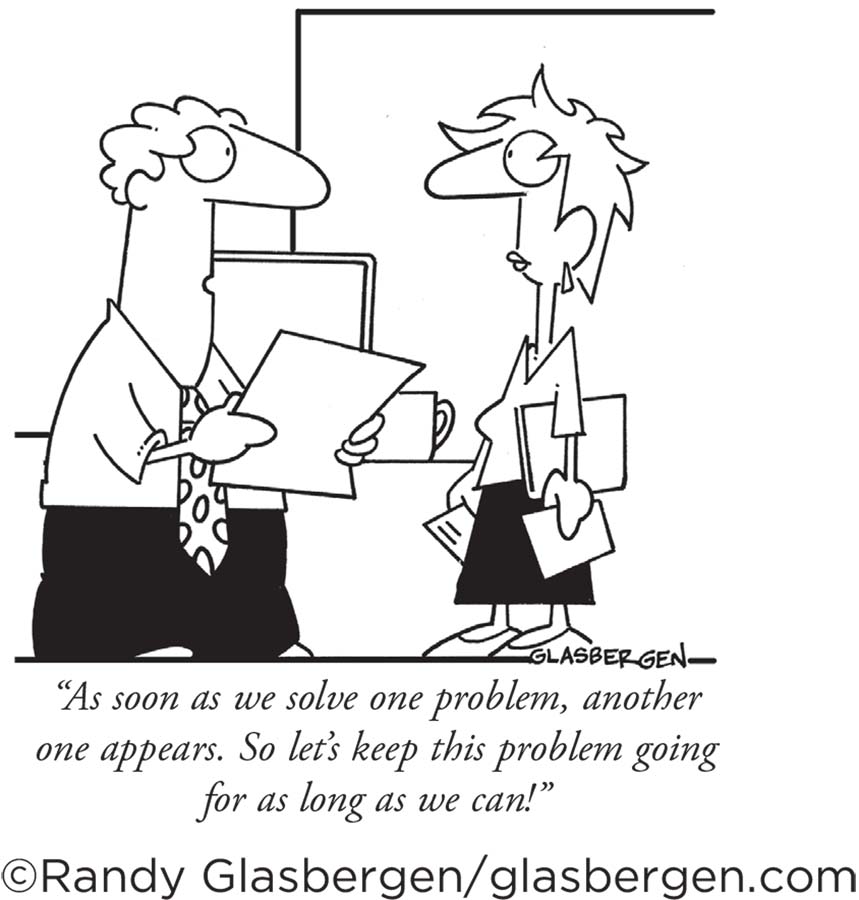
Have you ever considered the multitude of problems you encounter and solve every day? Problems crop up when something gets in the way of a goal, like a computer crashing when you are racing to finish a project or a tricky scheduling situation at work. Problems range from the mundane (my profile picture on Facebook is old ) to the potentially overwhelming (I have a life-
COMPONENTS OF PROBLEM SOLVING Problem solving has intrigued psychologists for generations. Newell, Shaw, and Simon (1958) developed an information-
Another crucial component of problem solving is recognizing obstacles that block the path to a solution (Matlin, 2013). Think about a problem you want to solve and try to identify the initial state, the goal state, and the obstacles in your way. If your initial state is unfinished homework and your goal state is the completion of your homework in a timely manner, the obstacles might include the competing duties of household chores or something more internal, like sleepiness or lack of motivation.
STEPS TO SOLVING PROBLEMS The first step in problem solving is understanding the problem (see Infographic 7.2, below). If you can’t identify or label a problem, then solving it is going to be difficult. Once you grasp the problem, you must choose one of many available approaches or strategies to tackle it. Which one you settle on—
Apply This
INFOGRAPHIC 7.2
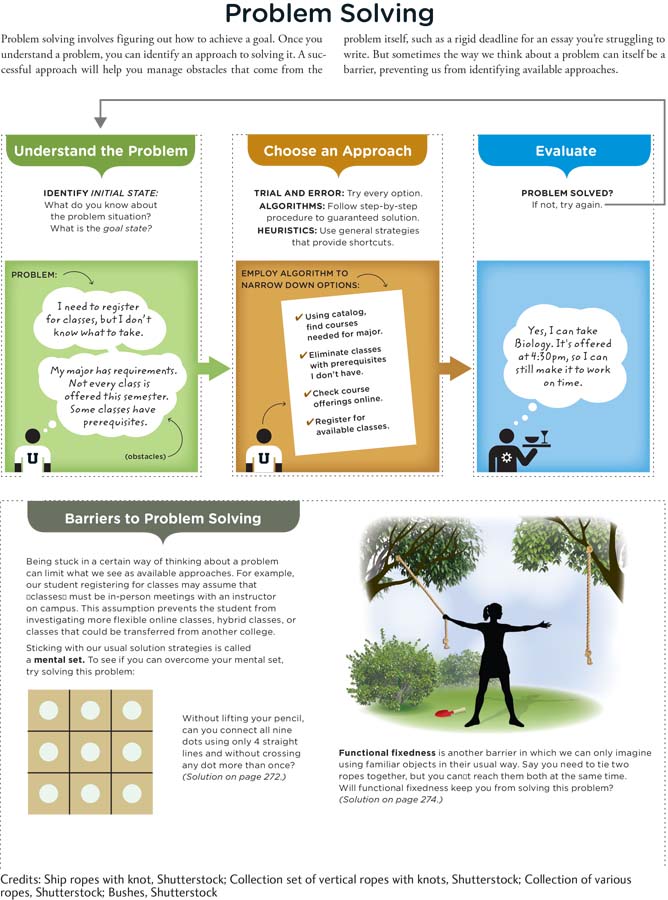
Problems are a constant part of life, but they are much easier to manage if we understand the strategies available to solve them. The aim of the upcoming discussion is to provide you with several approaches for solving problems, while also examining the various factors that come into play during the process.
Approaches to Problem Solving
LO 5 Explain how trial and error and algorithms can be used to solve problems.
trial and error An approach to problem solving that involves finding a solution through a series of attempts and eliminating those that do not work.
TRIAL AND ERROR One common approach to problem solving is trial and error, the process of finding a solution through a series of attempts. Mistakes will likely be made along the way, but attempts that don’t work are simply eliminated. Let’s say you have a HUGE set of keys and you have to unlock a door you don’t use very often. With the trial-
Trial and error is only useful in certain circumstances. It should not be used if the stakes are extremely high, particularly in situations where a wrong selection could be harmful or life-

Forgot your lock combination? Trying to figure it out by trial and error is not an effective strategy, as there are 64,000 possible solutions. Better buy a new lock.
Nor is this approach recommended for problems with too many possible solutions. If your keychain has 1,000 keys, you probably would not want to spend your time randomly selecting keys until one fits (potentially trying the same key more than once). Trial and error is somewhat of a gamble because there is no guarantee it will lead to a solution. By the way, computer hackers may use this approach to get your password and gain uninvited access to your digital world. More about this to come.
algorithm (al-
ALGORITHMS If you’re looking for a problem-
As reliable as algorithms may be, they are not always practical. If you don’t know the algorithm’s formula, you obviously cannot use it, and sometimes the steps may require too much time. Let’s return to our example of computer hacking. After losing patience with trial and error, the hacker designs an algorithm that generates a series of possible passwords made up of letters, numbers, and symbols. Because algorithms guarantee solutions, the hacker eventually will generate your password. But the question is: Will it happen in this century? If you have chosen your password wisely, the algorithm may not work within a time frame that the hacker is willing—
LO 6 Identify different types of heuristics used to solve problems.
heuristics (hyu̇-ris-
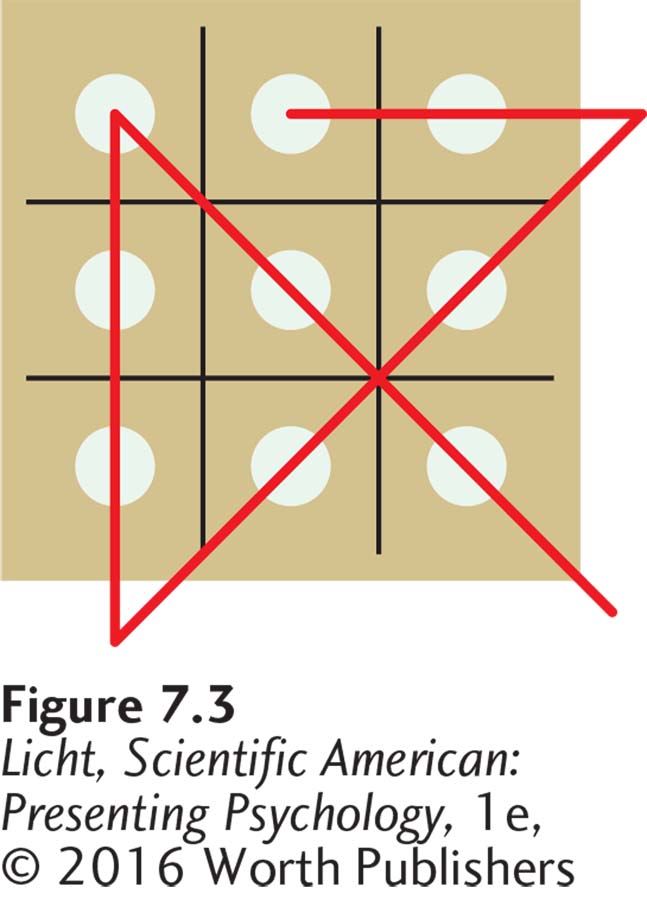
Did your mental set cause you to assume the square implied boundaries? If so, it may not have occurred to you that you could draw lines extending outside the square.
HEURISTICS If using an algorithm is not an option, which is often the case with everyday problems, we can turn to heuristics (hyu̇-ris-
Heuristics provide shortcuts, allowing you to ignore the many approaches you know will not work and move on to solutions more likely to be successful. But you might need to use trial and error to choose the best solution from that smaller pool of possibilities. A hacker might use a heuristic that combines a commonly used password (123456, password, football) and then add something from the domain itself. For example, if the hacker is trying to break into a Sony PlayStation account, her heuristic might be to try a variety of commonly used passwords and add “PS” at the end (123456PS, passwordPS, footballPS). She would then use trial and error until she breaks into the account. Most problems in life do not come with ready-
Heuristics come in a variety of forms. One commonly used heuristic involves creating subgoals or subproblems. In the days following her stroke, Dr. Jill had a great deal of trouble moving her body. One of her main challenges was sitting up, but she was able to solve this problem “by breaking the effort of sitting up into the smaller steps of rocking and then rolling upward” (Taylor, 2006, p. 93). When writing your last term paper, did you break it into shorter, more achievable parts? If so, you were using this type of heuristic, which instructors often recommend to students.
means–

In a classic study, Wolfgang Köhler provided chimpanzees with some out-
Another frequently used heuristic is means–
insight An understanding or solution that occurs in a sudden stroke of clarity (the feeling of “aha!”).
INSIGHT Another manner of reaching a solution is through insight, an understanding that occurs in a sudden stroke of clarity (that oh-
Insight happens so suddenly that we sometimes say to ourselves: Why did it take me so long to figure that out? The answer seems so obvious now. Theories suggest that, without our conscious awareness, our minds are busy reorganizing the way the problem is represented, and this allows us suddenly and inexplicably to see things in a new light. Sometimes stepping away from a problem for a short time allows the solution to “suddenly appear” (Sio & Ormerod, 2009). There is evidence that activity in the frontal and temporal lobes immediately precedes the “aha!” moment (Kounios & Beeman, 2009).
Wolfgang Köhler, a Gestalt psychologist, made some remarkable discoveries on insight in chimpanzees. As early as 1913, he created various problems for chimps to solve. For example, Köhler put bananas just out of the chimps’ reach, supplied them with various “tools” (crates, sticks, and so forth), and watched how they went about getting the bananas. The chimps were very clever; they stacked crates, used sticks, and managed to retrieve the bananas using what Köhler hypothesized was intelligence and insight (Köhler, 1925).
The Gestalt psychologists believed that humans and animals solve problems through perception and cognition—
Barriers to Problem Solving
functional fixedness A barrier to problem solving that occurs when familiar objects can only be imagined to function in their normal or usual way.

Who knew that a paint roller could be used for holding toilet paper and that car tires doubled as planters? Sometimes it’s hard to imagine using objects for unconventional purposes. Our resistance toward using familiar objects in new ways is known as functional fixedness, and it can get in the way of problem solving.
With the capacity for insight, we can be masterful problem solvers. But as you probably know from personal experience, great ideas do not always materialize when we need them; there are many barriers to problem solving (Infographic 7.2). One such barrier is functional fixedness, which occurs when we can only imagine using familiar objects in their usual way. This fixation can hinder problem solving, because it stops us from being able to find other, creative uses for objects. Suppose the hem of your pants gets caught on something and the thread starts unraveling. A roll of tape and a stapler are on your desk, and both could be used to “fix” your wardrobe malfunction. But because of functional fixedness, you only view these items in their “usual” capacities. Children have less trouble with functional fixedness than adults because they have not become accustomed to using familiar objects in a fixed way (German & Defeyter, 2000).
Mental sets represent another barrier to problem solving. When faced with a problem, we tend to fall back on solution strategies we have always used—
Emotional barriers can also get in the way of problem solving. If you are trying to figure out how to fix the dripping faucet and someone is peering over your shoulder saying, “Hurry up! What’s taking you so long?” you may feel rushed, anxious, and annoyed. These negative emotions affect your ability to think clearly and creatively. Positive emotions, on the other hand, may set the stage for innovative thinking. Good feelings are thought to promote a “flexible” way of thinking, one that enables quick attention shifting and the ability to develop new strategies in response to a changing environment (Isen, 2008). Keep this in mind when you are trying to help someone solve a problem.

Using a shovel to create a pendulum will allow you to swing the second rope. When it swings near you, you can grab it and hold both ropes at the same time.
Decisions, Decisions
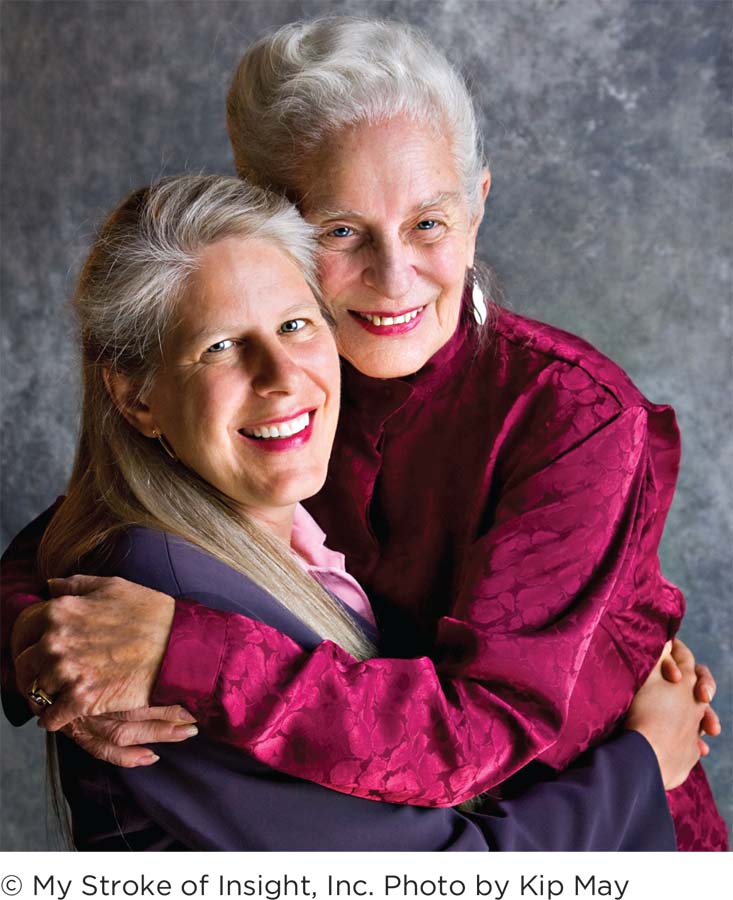
Dr. Jill poses with her mother, G.G., who played an instrumental role in the recovery process. When Dr. Jill emerged from surgery, G.G. was anxious to know whether her daughter’s language-
 UNDER THE KNIFE With the help of her mother’s gentle coaxing, Dr. Jill made the decision to go through with surgery. On the afternoon of December 27, 1996, she awoke in the recovery room with the left side of her head shaved clean and a 9-
UNDER THE KNIFE With the help of her mother’s gentle coaxing, Dr. Jill made the decision to go through with surgery. On the afternoon of December 27, 1996, she awoke in the recovery room with the left side of her head shaved clean and a 9-
“Say something!” demanded G.G., as she approached her daughter’s bedside (Taylor, 2006, p. 113). G.G. needed to know that her daughter could still use language. Surgeons had just spent hours poking around her left hemisphere, home to the language processing regions of Broca’s and Wernicke’s areas. The surgeons might have inadvertently short-
LO 7 Define decision making and explain how heuristics can lead us astray.
decision making The cognitive process of choosing from alternatives that might be used to reach a goal.
You may be wondering how decision making differs from problem solving. As you now know, problem solving refers to the variety of approaches we can use to achieve a goal. Decision making is the cognitive process of choosing from those alternative approaches. Thus, problem solving and decision making can occur at the same time.
PREDICTING THE FUTURE Decision making often involves predicting the future: What is the likelihood that Event A will occur under these circumstances? How about Event B? In cases like these, we can make an educated guess, but some situations lend themselves to more accurate guesses than others. If the weather channel predicts there is a 99% chance of thunderstorms today, it’s fairly safe to assume it’s going to rain. Better bring your umbrella.
But there are many times when predicting the future is like rolling dice—

SINGLE FEATURE There are many ways to go about making decisions. One way is to focus on a single aspect, or feature, of the situation. Let’s say you are trying to decide where to stop for gas. If your only criterion is cost, you will seek out the gas station with the cheapest gasoline, paying no attention to what kind of donuts they sell inside or how clean their bathroom may be. The single feature on which you are basing your decision (where to stop for gas) is the price of the fuel (not tasty donuts or a clean bathroom).
ADDITIVE MODEL The single-
The Trouble with Heuristics and the Confirmation Bias
At the start of the section, we mentioned that decision making often involves making predictions, and different scenarios afford different levels of certainty about the future. Heuristics, which involve a rule of thumb or a broad application of a strategy, can help predict the probability of an event occurring. Unfortunately, heuristics can also lead us astray in our assessment of situations and prediction of outcomes. Daniel Kahneman and Amos Tversky (1973) were among the first to systematically research the ways in which heuristics can be ineffective. They found that people are prone to ignore important information while using heuristics (Kahneman & Tversky, 1996). This is particularly true for the availability heuristic and the representativeness heuristic.
availability heuristic A decision-
CONNECTIONS
In Chapter 6, we described the recency effect, which is the tendency to remember items more accurately when they appear at the end of a list or series. Here, we discuss the tendency to remember similar events better if they have occurred recently.
THE AVAILABILITY HEURISTIC Using the availability heuristic, we predict the probability of something happening in the future based on how easily we can recall a similar type of event from the past. The availability heuristic is essentially a decision-
Imagine the year is 2010 and you have just learned about the mine collapse that left 33 Chilean workers trapped underground. If asked to predict the likelihood of a similar mining collapse occurring in the near future, your estimation would likely be higher than normal because you just heard about the Chilean incident. Our predictions using the availability heuristic are based on how easily we can recall similar events from the past, and the more recently a similar situation has occurred, the more easily it will be recalled. With an event still fresh in our minds, we are more likely to overestimate the odds of a similar event occurring in the future.
CONNECTIONS
In Chapter 1, we discussed the importance of using a representative sample for making generalizations from a sample to the population. With the use of the availability heuristic, we must be careful that the sample used is representative; sometimes the memories in our “sample” are not randomly selected. Instead, they are chosen because of their recency, frequency, familiarity, and vividness.
Now imagine that you were asked to decide the following: Do more students at your college use Macs or PCs? Before deciding how to answer, you would probably think about the number of students you have seen using these types of computers and make an estimation based on that tally. In this case, the frequency of occurrence influences your decision. You rely on your recall of seeing students using computers in the halls, classrooms, and library. If you are in the graphic design department, for example, chances are you’ll see more Macs than PCs. Based strictly on your observations from a single department, your sample would not be representative of the entire college, and the availability heuristic would lead you to the wrong answer. The availability heuristic can be accurate, but only when based on appropriate information.
The familiarity of an event might also lead to inaccurate estimates. If you and your friends are all avid PC users, you may overestimate the extent to which others are using PCs. The more familiar you are with a situation, the more likely you are to predict a similar occurrence in the future.
Finally, the vividness of an event can influence our recall. Try to conjure up an image of someone winning the “big one” at a casino. There are lights, sounds, and a lot of hubbub. The prizewinner jumps joyfully in the air, hollering and crying at the top of his lungs, with onlookers clapping and shouting in approval. This type of dramatic display never occurs when some poor guy loses his last $100; the details of a losing bet would consequently be far more difficult to recall. Because the winning image is more vivid, we are more likely to recall it and thus to overestimate the likelihood it will occur in our own lives. Memorable imagery leads us to believe that these types of wins happen all the time, when in fact they are very rare. If an event has made a striking impression on you, even a rare occurrence such as an airplane crash, you will be more likely to overestimate the probability of it happening again (Tversky & Kahneman, 1982).
THINK again
Fearing the Friendly Skies
 Are people generally more afraid of flying in an airplane or riding in a car? Airplanes seem frightening to many people, yet the statistics suggest we should be more concerned about driving. The odds of getting into a fatal traffic accident are 1 in 98, compared to about 1 in 7,000 for a plane crash (National Safety Council, 2012).
Are people generally more afraid of flying in an airplane or riding in a car? Airplanes seem frightening to many people, yet the statistics suggest we should be more concerned about driving. The odds of getting into a fatal traffic accident are 1 in 98, compared to about 1 in 7,000 for a plane crash (National Safety Council, 2012).

The odds of dying in a plane crash are extremely low—
SIT BACK, RELAX AND ENJOY THE FLIGHT
Now consider the weeks and months following the terrorist attacks of September 11, 2001. How did people feel about flying after seeing what happened to the hijacked planes on the news? Countless people stayed away from airports and airplanes. So many would-
Risk perception is complex. A number of factors contribute to an overblown fear of flying. The fact that airplane crashes and terrorist attacks are beyond one’s control and represent the potential for enormous disaster tends to increase many people’s perceptions of risk (Slovic & Weber, 2002, April). And, as we’ve learned from our earlier discussion of the availability heuristic, people tend to deem events more probable when similar scenarios are easy to recall. 
representativeness heuristic A decision-
THE REPRESENTATIVENESS HEURISTIC Sometimes we have to make decisions based on our judgment of a situation or person. The representativeness heuristic evaluates the degree to which their primary characteristics are similar to our prototypes. With the representativeness heuristic, we make quick, effortless judgments about how closely a person or situation fits our preconceived prototype (Shah & Oppenheimer, 2008). In contrast, the availability heuristic requires us to access information from long-
Let’s examine how the representativeness heuristic works in practice. Peter is a middle-
confirmation bias The tendency to look for evidence that upholds our beliefs and overlook evidence that runs counter to them.
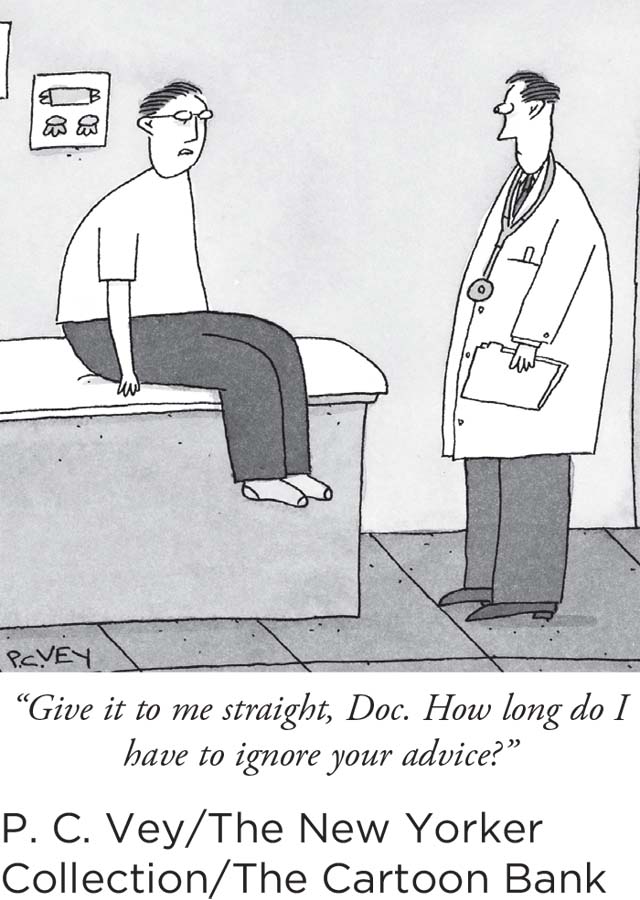
THE CONFIRMATION BIAS We can also miss important information through the confirmation bias, when we unintentionally look for evidence that upholds our beliefs. People tend to overlook or discount evidence that runs counter to their original beliefs or positions. For example, you decide to go on a date with someone you are really interested in, even though you don’t know him very well. You Google stalk him and look on his Facebook page, and immediately connect with one of the “likes” he has. With this information in hand, you stop your search, convinced you now have evidence to support your decision to go out with him. We tend to focus on information that supports favorable outcomes (Krizan & Windschitl, 2007; Scherer, Windschitl, O’Rourke, & Smith, 2012), but what other sources of information could you use to avoid the confirmation bias in this case? The danger of the confirmation bias is that we miss or ignore relevant (and possibly contradictory) information without conscious intent; we don’t deliberately set out looking for information to support what we already think.
You’ve Been Framed!
We have spent a great deal of time discussing factors that impede the decision maker. But in many situations, the characteristics of the problem itself, or the presentation of the problem, are to blame.
framing effect Occurs when the wording of questions or the context of a problem influences the outcome of a decision.
WHAT’S IN A FRAME? The framing effect demonstrates how the presentation or context of a problem can influence the outcome of a decision. To look at this effect, researchers conducted a study in which they instructed participants to imagine that they had purchased a $10 ticket to attend a show, but lost their ticket on the way to the theater. Each participant was then asked whether he or she would be willing to pay $10 for another ticket. Only 46% of participants indicated that they would spend another $10 for a new ticket. Participants were next instructed to imagine another situation: In it, they planned to buy a $10 ticket to attend a show, but once they got in the ticket line, they suddenly realized that they had lost one of their $10 bills. Faced with this second scenario, 88% of the participants were willing to fork over the $10. In each case, the participants were faced with the proposition of spending an additional and unexpected $10, but they tended to make different decisions in response to the different circumstances. The background information framing these hypothetical scenarios influenced the decisions made, even though the outcomes would have been identical—
WHAT’S IN A QUESTION? The specific wording of questions should also be considered. One study found that people are more likely to prefer ground beef if it is described as “80% lean,” as opposed to “20% fat.” Although 80% lean and 20% fat describe exactly the same product, these phrases evoke very different responses (Johnson, 1987). Another study investigated the effects of question framing on women using a telephone-
THINK again
Let Them Eat Cake
 Decisions can also be influenced by how much we have “on our plate” at a given time. Imagine making a decision when you are trying to cook dinner, watch the nightly news, and discipline your dog all at the same time. External demands can have a powerful impact on how we make decisions. In one study, researchers asked a group of participants to memorize two numbers and another group to keep a string of seven numbers in their minds. Meanwhile, both groups were offered the choice of fruit or chocolate cake. Surprisingly, the people who only had to memorize the two numbers selected the fruit every time, whereas those trying to remember the string of seven numbers tended to choose the cake (Shiv & Fedorikhin, 1999)! What this suggests is that our stress level impacts our decisions—
Decisions can also be influenced by how much we have “on our plate” at a given time. Imagine making a decision when you are trying to cook dinner, watch the nightly news, and discipline your dog all at the same time. External demands can have a powerful impact on how we make decisions. In one study, researchers asked a group of participants to memorize two numbers and another group to keep a string of seven numbers in their minds. Meanwhile, both groups were offered the choice of fruit or chocolate cake. Surprisingly, the people who only had to memorize the two numbers selected the fruit every time, whereas those trying to remember the string of seven numbers tended to choose the cake (Shiv & Fedorikhin, 1999)! What this suggests is that our stress level impacts our decisions—
HOW MUCH DO YOU HAVE ON YOUR PLATE?
show what you know
Question 1
1. Imagine it is the first day of classes, but you forgot to write down the number of the room where your psychology class is meeting. You decide you will try to find your classroom by sticking your head in a random number of rooms until you see the assigned psychology textbook on someone’s desk. This approach to finding your classroom uses:
means–
ends analysis. an algorithm.
trial and error.
heuristics.
c. trial and error.
Question 2
2. One assignment in your psychology class is to design an experiment. Describe how you would use means–
Answers will vary. A means–
Question 3
3. _________ refers to the cognitive process of choosing from a variety of alternatives you might use to reach your goal.
Decision making
Question 4
4. We often predict the probability of an event happening in the future based on how easily we can recall a similar type of event from the past. This is known as the:
framing effect.
confirmation bias.
representativeness heuristic.
availability heuristic.
d. availability heuristic.
Question 5
5. A good friend is terrified of flying. How would you use your knowledge of heuristics to make him feel less afraid?
Answers will vary. A heuristic uses a “rule of thumb” or a broad application of a strategy to solve a problem, but it can also be used to help predict the probability of an event occurring. However, heuristics can lead us astray in our assessment of situations or predictions of outcomes. In the current example, you can present information to your friend that indicates flying is the safest form of travel. But you can also describe how the availability heuristic might lead him to believe that air travel is not safe. The vividness of airplane crashes can influence his recall; even though they are rare events, he is likely to overestimate the probability of them happening again due to the ease with which he recalls similar events. Highly detailed media reports of an airplane crash are likely to linger in his memory.